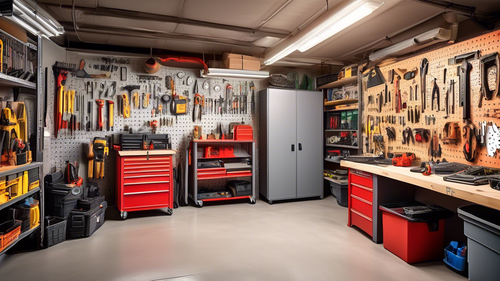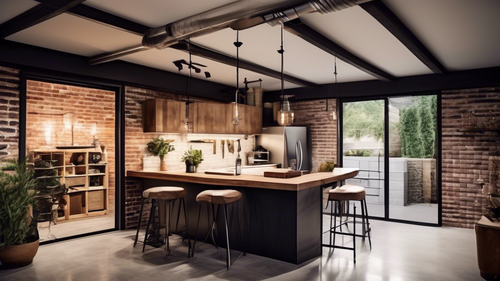
Craft Your Perfect Nightstand With Expert DIY
Share
I'm taking the DIY challenge and transforming a blank space into my perfect nightstand. I start by building the box, cutting four pieces of 3/4 PureBond Plywood Birch to size and assembling them with pocket holes and Gorilla Wood Glue. Next, I add a planked top and secure it with finish nails, then stain it with Varathane Ash for a beautiful finish. To complete the look, I choose complementary hardware and employ drawer organization techniques. With these expert techniques, I'm confident I can create a functional piece of furniture that suits my style. Now, let's get into the nitty-gritty details that'll make my nightstand truly exceptional.
Key Takeaways
• Create a sturdy nightstand box by cutting 3/4 PureBond Plywood Birch into required dimensions and assembling with pocket holes and wood glue.
• Add a beautifully finished top with planked wood, aligned with pocket holes and secured with wood glue and finish nails.
• Achieve a lustrous finish by applying Varathane polyurethane, and choose hardware that complements the stain for a cohesive look.
• Utilize DIY resources like woodworking forums, YouTube channels, and online communities to find inspiration, tutorials, and project support.
• Plan and budget your project by calculating total costs, considering material and tool expenses, and setting aside a contingency fund for unexpected expenses.
Building the Nightstand Box
As I begin constructing my perfect nightstand, I start by cutting four pieces of 3/4 PureBond Plywood Birch to the required dimensions for the nightstand box, ensuring a sturdy foundation for my bedside haven.
I carefully select this plywood for its durability and aesthetic appeal.
Next, I create pocket holes using my trusty Kreg Jig, preparing for a seamless pocket hole assembly.
With the box taking shape, I attach the base to the sides using Gorilla Wood Glue and pocket hole screws, ensuring a rock-solid foundation.
Finally, I add the top pieces, carefully aligning them with 3/4 pocket holes and a right angle clamp.
With the box built, I'm excited to move on to the next stage of my DIY project.
Adding the Finishing Touches
I secure the planked top with pocket holes, wood glue, and finish nails, adding a touch of rustic charm to my nightstand.
Next, I focus on hardware selection, choosing decorative accents that complement the Varathane Ash stain. I opt for Home Depot hardware that adds a touch of elegance to my DIY project.
To enhance the functionality of my nightstand, I employ clever drawer organization techniques, ensuring each drawer glides smoothly and efficiently.
Finally, I apply my staining techniques, carefully coating the wood with Varathane polyurethane to achieve a rich, lustrous finish.
With these finishing touches, my nightstand is transformed into a beautiful, functional piece of furniture that's sure to impress.
DIY Community and Resources
Connecting with fellow DIY enthusiasts and experts in online forums and communities has proven invaluable in refining my woodworking skills and staying updated on the latest techniques and trends. Through these online resources, I've gained access to a wealth of DIY inspiration, online tutorials, and community support.
Here are a few of my go-to resources:
-
Woodworking forums like Woodworking Talk and The Wood Whisperer, where I can ask questions and get feedback from experienced woodworkers
-
YouTube channels like The King of Random and DIY Projects, which offer a vast array of DIY tutorials and projects
-
Online communities like Reddit's r/woodworking, where I can share my projects and get feedback from a community of like-minded individuals
- Websites like The Family Handyman and Fine Woodworking, which provide in-depth tutorials and project plans
Product and Material Reviews
When it comes to selecting the perfect products and materials for my woodworking projects, I've learned to rely on a few trusted brands and sources that consistently deliver high-quality results. For instance, I've had great success with Varathane products, particularly their Ash stain and Triple Thick Polyurethane.
In fact, I often find myself comparing Minwax vs. Varathane, and while both have their strengths, Varathane tends to be my go-to. One trick I've mastered is thinning Varathane polyurethane for spraying, which makes application a breeze. I've also experimented with Varathane's 3x poly for a rich, smooth finish.
Project Costs and Logistics
Three essential factors when calculating the total cost of your nightstand project are the materials, tools, and shipping expenses.
To get an accurate estimate, consider the following:
-
Materials: Calculate the cost of plywood, lumber, and hardware based on your design and measurements.
-
Tools: Factor in the cost of any new tools you need to purchase or rent, such as a Kreg Jig or right angle clamp.
-
Shipping expenses: Research shipping options and pricing strategies to find the most cost-effective delivery services for your project's components, like ordering legs from Osborne website.
- Contingency fund: Don't forget to set aside a buffer for unexpected expenses that might arise during the project.
Frequently Asked Questions
Can I Use MDF Instead of Purebond Plywood for the Nightstand Box?
As I envision my nightstand, I ponder, 'Can I swap MDF for PureBond plywood?' While MDF alternatives seem appealing, I'd caution against it; plywood's durability and stability are essential for supporting the weight of drawers and hardware, ensuring smooth slide maintenance.
Are Pocket Hole Screws Necessary for Assembling the Face Frame?
"I opt for pocket hole screws for assembling the face frame, but alternatives like wood glue and nails or dominos work too. A sturdy face frame design enhances nightstand aesthetics, so choose the method that fits your style and skill level."
How Do I Ensure the Drawers Slide Smoothly on the Wood Slides?
'To guarantee smooth-sliding drawers, I apply a drawer lubricant to the wood slides, then fine-tune the sanding technique for a silky finish. Proper drawer alignment is key, so I double-check it before securing with wood glue.'
What Is the Ideal Thickness for the Planked Top?
"I opt for 3/4-inch thick planked tops, striking a balance between durability and aesthetics. When choosing materials, I prioritize quality, ensuring a sturdy surface for my nightstand. Finishing touches, like Varathane stain, bring out the beauty in the wood."
Can I Use a Different Type of Stain Besides Varathane Ash?
I opt for alternative finishes, exploring staining options beyond Varathane Ash; I consider Minwax, PolyShades, or Zinsser, weighing their pros and cons to achieve the perfect hue for my DIY nightstand masterpiece.
Related Posts
-

Garage Organization 101
Garage Organization 101: The Ultimate Guide to a Tidy and Efficient Workspace Are you tired of stepping into your ...
-

Transforming Your Garage into a Haven of Style
Is your garage an unorganized chaos of clutter and forgotten dreams? Don't despair! With a little imagination and...
-

Best Stackable Containers for Flour Storage
When it comes to storing flour, you need stackable containers that prioritize freshness and organization. Look for ai...


